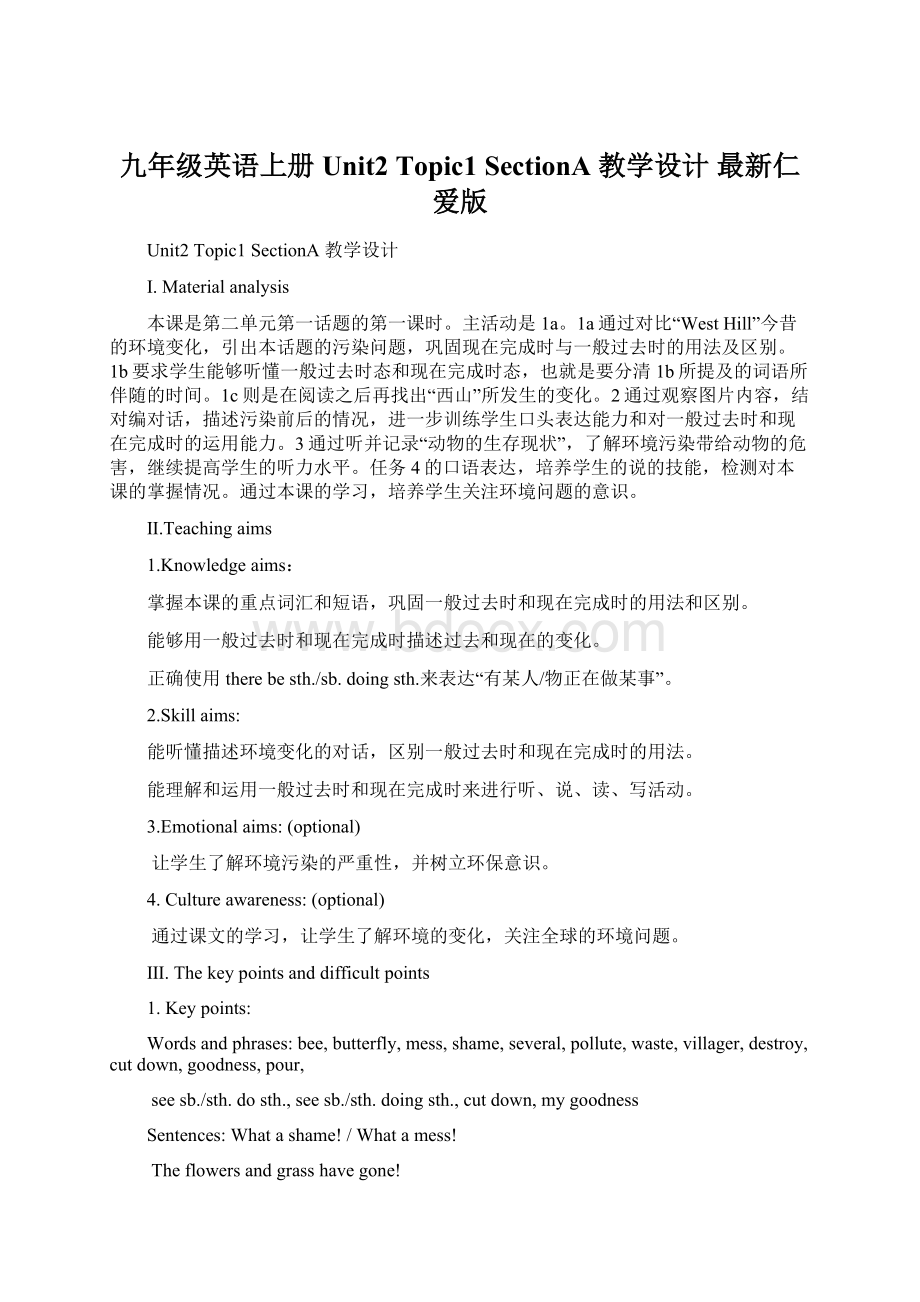九年级英语上册Unit2 Topic1 SectionA 教学设计 最新仁爱版.docx
《九年级英语上册Unit2 Topic1 SectionA 教学设计 最新仁爱版.docx》由会员分享,可在线阅读,更多相关《九年级英语上册Unit2 Topic1 SectionA 教学设计 最新仁爱版.docx(13页珍藏版)》请在冰豆网上搜索。

九年级英语上册Unit2Topic1SectionA教学设计最新仁爱版
Unit2Topic1SectionA教学设计
Ⅰ.Materialanalysis
本课是第二单元第一话题的第一课时。
主活动是1a。
1a通过对比“WestHill”今昔的环境变化,引出本话题的污染问题,巩固现在完成时与一般过去时的用法及区别。
1b要求学生能够听懂一般过去时态和现在完成时态,也就是要分清1b所提及的词语所伴随的时间。
1c则是在阅读之后再找出“西山”所发生的变化。
2通过观察图片内容,结对编对话,描述污染前后的情况,进一步训练学生口头表达能力和对一般过去时和现在完成时的运用能力。
3通过听并记录“动物的生存现状”,了解环境污染带给动物的危害,继续提高学生的听力水平。
任务4的口语表达,培养学生的说的技能,检测对本课的掌握情况。
通过本课的学习,培养学生关注环境问题的意识。
Ⅱ.Teachingaims
1.Knowledgeaims:
掌握本课的重点词汇和短语,巩固一般过去时和现在完成时的用法和区别。
能够用一般过去时和现在完成时描述过去和现在的变化。
正确使用therebesth./sb.doingsth.来表达“有某人/物正在做某事”。
2.Skillaims:
能听懂描述环境变化的对话,区别一般过去时和现在完成时的用法。
能理解和运用一般过去时和现在完成时来进行听、说、读、写活动。
3.Emotionalaims:
(optional)
让学生了解环境污染的严重性,并树立环保意识。
4.Cultureawareness:
(optional)
通过课文的学习,让学生了解环境的变化,关注全球的环境问题。
Ⅲ.Thekeypointsanddifficultpoints
1.Keypoints:
Wordsandphrases:
bee,butterfly,mess,shame,several,pollute,waste,villager,destroy,cutdown,goodness,pour,
seesb./sth.dosth.,seesb./sth.doingsth.,cutdown,mygoodness
Sentences:
Whatashame!
/Whatamess!
Theflowersandgrasshavegone!
Whathashappenedhere?
Therebesth./sb.doingsth.
Thereareseveralfactoriespouringwastewaterintothestream.
Everythinghaschanged.
Grammar:
differencesbetweenSimplePastandPresentPerfecttense.
2.Difficultpoints:
正确使用therebesth./sb.doingsth.来表达“有某人/物正在做某事”。
区别使用短语seesb./sth.dosth.和seesb./sth.doingsth.。
能正确地以口头和书面形式区别使用一般过去时和现在完成时。
Ⅳ.Learningstrategies
通过引导学生在听前阅读1b和3,培养学生形成听前熟悉、预测听力材料的习惯。
通过朗读1a和2,引导学生模仿已有对话,编写新的对话。
通过1c,培养学生整合对话信息,将对话转换为语篇的能力。
Ⅴ.Teachingaids
图片(关于校园周边环境变化对比图或者影像资料),录音机,幻灯片等。
Ⅵ.Teachingprocedures
Stage
(timeperiod)
Interaction
patterns
Teacheractivity
Studentactivity
Remarks
1
Gettingstudentsreadyforlearning
(1min)
Classactivity
Greetandtalkabouttheweather.LeadtheSstodiscusstherightplaceforapicnic.
T:
Hi,boysandgirls!
It’saniceday,isn’tit?
Ss:
Yes.
T:
Wouldyouliketohaveapicnicwithme?
Ss:
I’dlikethat./Soundsgreat.
T:
Sowhereshallwego?
Ss...
Greetandfocustheirattentionontheteacher.
...
Ss:
Yes.
Ss:
I’dlikethat./Soundsgreat.
Ss...
通过谈论天气,要去野炊,吸引学生的注意力,也符合课文主题,使学生专注于课堂。
如果天气不好,也可以做好周末的野炊计划。
2
Lead-in
(3-5mins)
Groupwork
LettheSsdiscusswheretohaveapicnic.Encouragethemtostatethereasons.
T:
Nowworkingroups,choosethebestplaceforapicnicandtelltheclasswhyyouchoosethatplace.
Ss…
T:
OK,telluswheretohaveapicnic.Why?
S1:
Ithink…isthebestchoice.Theairthereisfresh.Wecanflykitesonthegrass.
S2…
Discusswheretohaveapicnicandstatethereasons.
…
Ss…
S1:
Ithink…isthebestchoice.Theairthereisfresh.Wecanflykitesonthegrass.
S2…
先让学生讨论出合适的野炊地点,老师再出示西山没被污染的图片来吸引学生的注意。
当学生兴趣高涨时,又呈现被污染后的图片,让学生满怀兴趣和疑问去了解西山被污染前后的状况,更好的体会一般过去时和现在完成时在语境中的运用,同时也突破了单词关。
3
Pre-listening
(5-7mins)
Classactivity
PresenttwopicturesoftheWestHillanddescribethechanges.Teachthenewwordsandsomedifficultsentences.
(ShowtheoldpictureoftheWestHilltotheSs)
T:
Lookatthisbeautifulpicture.Kangkangandhisfriendshadapicnictheretwoyearsago.Canyouguesswhereitis?
Ss:
Yes,it’stheWestHill.
T:
Whatcanyouseeinthepicture?
S1:
Someflowers,acleanriverandabigtree…
T:
Right.TheWestHillisabeautifulplace.Canyouseethebeesandbutterfliesdancingthere
(Pointtothebeesandbutterflies,andthenwritedownthewordsandphrasesontheBb)
T:
Sodoyouwanttogothereforapicnic?
Ss:
Yes…
T:
I’dliketo.Butnowithaschangedalot.Lookatthispicture.Doyoulikeit?
Ss:
No.
(Teacherpresentsthenewwordsanddifficultsentencesthroughthedescriptionofthepicture.)
WatchthepicturesoftheWestHill,guessthemeaningandpronunciationofthewordsaccordingtotheintroductionaboutthechangesoftheWestHill.
Ss:
Yes,it’stheWestHill.
…
S1:
Someflowers,acleanriverandabigtree…
…
Ss:
Yes…
…
Ss:
No.
在教授新单词时,老师应当同时呈现单词和音标,让学生运用所学音标自己解决单词的读音问题,如果学生发音不准,老师要及时更正。
再根据图片和讲解,引导学生大胆的猜测词义和部分难句的意思,为1a中的听力对话扫障碍。
4
While-listening
(10mins)
Individualwork
Groupwork
Step1:
LettheSslistento1atwiceanddo1balone.
T:
ListentothetapecarefullyandtrytomarkthewordswithPorN.
…
T:
Nowpleasecheckanswersinyourgroup.
S1:
“Beautiful”isinthepast.
S2:
“Butterflies”areinthepast.
S3:
“Dirty”isnow.
…
Step2:
LettheSslistento1aagainandpayattentiontothepronunciationandtheintonation.Thenpractice1aingroupsandroleplayit.
T:
Read1awithyourgroupmembersandactitout.
ListenandmarkthewordswithPorNaccordingtothetape.
.
S1:
“Beautiful”isinthepast.
S2:
“Butterflies”areinthepast.
S3:
“Dirty”isnow.
…
Listento1aagainandpayattentiontothepronunciationandtheintonation.Thenpractice1aingroupsandroleplayit.
本课对话不长,词汇量不大,可以直接在组内核对答案。
如果对话较长,难度较大,建议先听两遍后再读,通过读来检查听的结